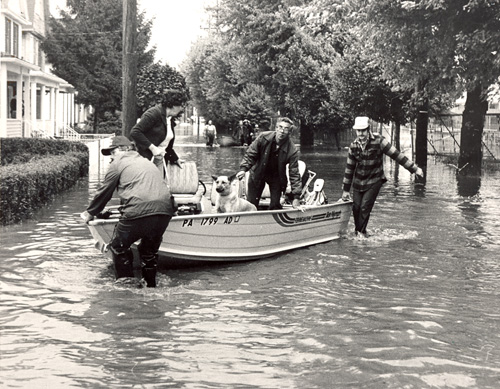Speaking of Hill briefings (LOTRW, July 10), a July 9th briefing on the House side merits your attention. Congress Matt Cartwright (PA-17) took the lead… part of his effort to develop and introduce legislation to build national resilience to extreme events. He’s given his bill the title The PREPARE Act (Preparedness and Risk management for Extreme weather Patterns Assuring Resilience). Congressman Cartwright’s district includes much of northeastern Pennsylvania, which has seen its share of floods over the years, including, notably, Hurricane Diane in 1955[1] and Hurricane Gloria in 1985. The fixed-image below is from that latter event:
The work itself is in an early, formative stage (Mr. Cartwright is looking to drop the bill toward the end of the month), but there are elements about both the bill and Wednesday’s briefing to like. Let’s begin with the bill. The draft takes as its starting point the latest GAO High-Risk List, discussed in two LOTRW posts in February of 2013, highlighting the financial risk that unfunded, unanticipated disaster losses from extreme events pose to the United States. The bill recognizes that pre-event mitigation versus emergency response offers the biggest potential for payoff. The bill emphasizes federal agency coordination, and proposes a new Interagency Council to accomplish this purpose; perhaps one way to look at this is the Subcommittee on Disaster Reduction currently operated out of OSTP on steroids. But the bill doesn’t stop there; it stresses that public-private partnership at the local, community level is vital to success. It calls for federal agencies to more actively identify and develop working relationships with groups at state and local levels. In many ways this is consistent with Building Community Disaster Resilience through Private-Public Coordination and other recent NAS/NRC studies; and with emerging federal efforts such as the NOAA/NWS Weather-Ready Nation initiative. The American Meteorological Society has written a letter referencing the bill stating that it “strongly supports legislative efforts that will increase the resiliency of our nation to natural hazards of all types.”
For the briefing itself, Congressman Cartwright turned to both ends of the political spectrum, as well as the middle, and the private-sector as well as the public sector. His first panelist was Eli Lehrer, President and Founder of the R Street Institute, a think tank promoting free markets and limited, effective government. Richard Eidlin, Co-founder and Director for Business Engagement of the American Sustainable Business Council, was the second speaker. Speaking third was Shannon Sly, Senior Counsel, Marstel-Day, LLC, with a military background both in uniform and as a civilian, who described himself as apolitical. Congressman Cartwright and the speakers maintained an easy dialog as they stressed the importance and non-political nature of the challenge of preparing for extreme events. The Congressman seems to have quite a track record for working across the aisle and it showed in the discussion. Mr. Cartwright stressed at the briefing’s conclusion that the bill is very much a work in progress and invited people to reach out to Jeremy Marcus, his Deputy Chief of Staff and Legislative Director (jeremy.marcus@mail.house.gov), whom he credited with much of the work behind the bill, with requests for more information or for comments.
[1]You can find a video of the Hurricane Diane event here.


